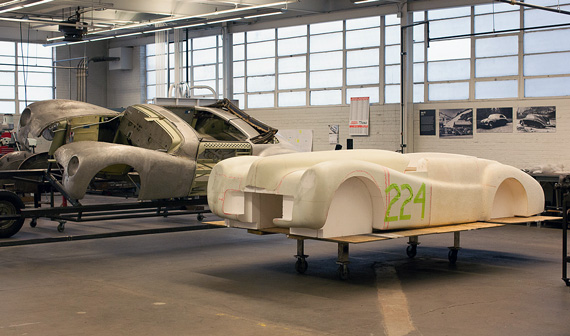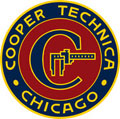
Bucking the trend: The finished buck created with CAD technology, laser scanning, digital imaging and 3D printing – all cutting-edge tools that Cooper Technica has incorporated into an innovative and unique approach to high-end automobile restoration. The finished buck is shown next to the body, which is mounted on a rotisserie fixture in Cooper Technica’s Chicago studio.
Begin at the Beginning:
Historical Research and Forensic Sleuthing Inform the Restoration of a 1943 Alfa Romeo Part II READ Part 1
© 2015 David Cooper, President, Cooper Technica, Inc.
Introduction
During the Second World War, Alfa Romeo built twenty-eight 6C2500 Super Sport Cabriolets. These were built exclusively for Mussolini’s close friends and associates – mostly high-ranking German officers. Seven of these cars had custom cabriolet bodies designed by renowned Italian coachbuilder Pinin Farina. Cooper Technica, Inc. is now restoring one of these seven, originally built for Luftwaffe Field Marshal Wolfram Freiherr von Richthofen, a cousin of the WWI Red Baron and an ace pilot himself. In 1948, in the hands of a new owner, this car raced Italy’s famous Mille Miglia, finishing 3rd in class and 22nd overall. Altogether, the Alfa Romeo’s unique history and provenance make it particularly desirable to collectors today.
Part I of this article described how Cooper Technica first acquired the car, and then meticulously researched its complete history, provenance, and construction documentation. We found that, throughout its life, the Super Sport changed hands seven times, sustained a few minor crashes, and had its front end altered when the body was repaired in Milan in 1953. This historical record, as costly and time-consuming as it was to gather, proved essential to restoring the valuable Alfa to the highest achievable standards of authenticity.
Part II of this article will first explain the rationale behind key restoration decisions. Then, we will describe how Cooper Technica used the cutting-edge technology of laser scanning, digital imaging and 3D printing to determine the Alfa’s original shape; and then used traditional “trailing-edge” construction techniques to restore that shape. With archival photos from 1943 and 1945 as our guides, our innovative methods and unique approach have achieved a restored body shape within two millimeters of the original – a level of precision never before possible.
When Preservation Is Not an Option, What Then?
As both historians and restorers, our first goal is to preserve the car as-is, rather than to restore it. When the Alfa Romeo arrived at Cooper Technica, the paint had been stripped, exposing the original aluminum body skin. It was evident that various repair jobs and past alterations had left the body in poor condition. Given that that car was no longer original, and the fact that some restoration work had already been attempted, preservation was not a viable option.
